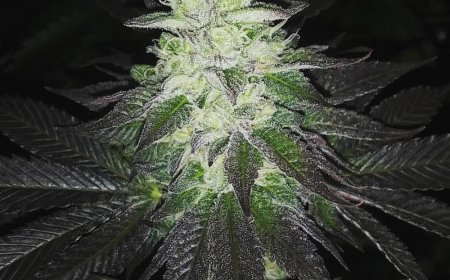What to Watch on Shrooms: Ultimate Mind-Blowing Guide
Explore our ultimate guide on what to watch on shrooms, featuring comedies, animations, documentaries, TV shows and music videos for a mind-blowing trip.

When embarking on a journey with magic mushrooms, the active ingredient psilocybin can heighten your senses and alter your perception of reality. As such, selecting the right visual content is crucial for an enjoyable experience. In this article, we'll present you with some great choices for what to watch while taking magic mushrooms.
We've carefully curated a list of comedy movies that will have you laughing uncontrollably while also providing a visually stimulating experience. Additionally, animated movies offer vivid colours and captivating stories that blend seamlessly with the effects of magic mushrooms.
For those interested in exploring deeper themes during their trip, our selection of TV shows caters to various tastes while maintaining an element of surrealism perfect for watching on shrooms. Lastly, music videos and concerts are excellent choices for those seeking auditory stimulation alongside striking visuals.
Dive into this comprehensive guide as we explore what to watch on shrooms for a truly memorable experience.
Table of Contents:
- Comedy Movies
- a. Superbad
- b. Pineapple Express
- c. Harold and Kumar Go to White Castle
- Animated Movies
- TV Shows
- Music Videos/Concerts
- Frequently Asked Questions What to Watch on Shrooms
- Conclusion

1. Comedy Movies
While tripping on magic mushrooms, comedy movies can be an excellent choice to enhance your experience and keep the mood light-hearted. The following films are known for their hilarious scenes, absurd situations, and memorable characters that will have you laughing out loud during your shroom trip.
a. Superbad
Superbad is a coming-of-age story about two high school friends trying to make the most of their last days before college starts. This uproarious comedy, featuring the memorable acting of Jonah Hill and Michael Cera, will have you in stitches as it recounts a tale of two pals trying to make the most out of their last days before college.
b. Pineapple Express
In Pineapple Express, Seth Rogen and James Franco play stoners who get caught up in a dangerous drug-related adventure after witnessing a murder. This outrageous comedy offers a wild ride with plenty of laughs along the way.
c. Harold and Kumar Go to White Castle
A classic stoner film with an amusing twist: Harold and Kumar Go to White Castle tell the story of two friends who embark on an epic quest for delicious burgers from White Castle after getting high on marijuana one night - only things don't go quite as planned. With bizarre encounters and hilarious mishaps along the way, this movie is a perfect choice for anyone looking to add some humour to their shroom trip.
For a more animated entertainment experience, why not try out some of the exciting animated movies available? Animated movies provide an exciting experience with their unique visuals and stories that can take you on a wild ride.
2. Animated Movies
If you're looking for a visually stunning and immersive experience while on magic mushrooms, animated movies are the way to go. These films often feature colourful visuals, imaginative worlds, and engaging storylines that can captivate your mind during your trip.
a. The Lego Movie
The Lego Movie is an excellent choice for those tripping on shrooms due to its vibrant colours, fast-paced action scenes, and quirky humour. This film follows the adventures of Emmet Brickowski (voiced by Chris Pratt), an ordinary LEGO mini-figure who is mistakenly identified as the "Special" - someone prophesized to save their world from evil forces led by Lord Business (Will Ferrell). As you watch this movie unfold in all its blocky glory, you'll be amazed at how well it combines nostalgia with cutting-edge animation techniques.
b. WALL-E
WALL-E, Pixar's masterpiece about a lonely robot tasked with cleaning up Earth after humanity has abandoned it for space luxury resorts, offers a more introspective viewing experience while on shrooms. With minimal dialogue throughout most of the film and an emphasis on visual storytelling, WALL-E invites viewers into a contemplative journey exploring themes like environmentalism and consumerism without feeling preachy or heavy-handed. Its beautiful animation will leave you mesmerized as you follow WALL-E's quest to find love and purpose in his seemingly bleak existence.
In addition to these recommendations,
Animated films can be a fun way to investigate the realms of psychedelics and shrooms, whereas documentaries offer an expansive analysis of this captivating subject. Moving on, let's take a closer look at some popular documentaries about magic mushrooms.
3. TV Shows
Submerging oneself in an entrancing and vibrant TV show while under the influence of magic mushrooms can be a remarkable experience. The combination of intricate storylines, colourful visuals, and thought-provoking themes make these shows perfect for your psychedelic journey.
a. Rick and Morty
Rick and Morty is an animated sci-fi comedy series that follows the adventures of eccentric scientist Rick Sanchez and his good-hearted but easily influenced grandson, Morty Smith. With its unique blend of humour, complex narratives, mind-bending alternate realities, and striking animation style, this show is sure to keep you entertained while enhancing your shroom trip.
b. BoJack Horseman
BoJack Horseman is another animated series that's perfect for watching on shrooms due to its introspective nature and dark humour. Set in a world where anthropomorphic animals coexist with humans, the show revolves around washed-up sitcom star BoJack as he tries to navigate through life after fame while dealing with addiction issues along the way. The mix of surreal visuals combined with deep emotional exploration makes it ideal for those seeking more profound experiences during their trip.
c. Adventure Time
If you prefer something lighter yet still visually stunning during your mushroom adventure, Adventure Time is just what you need. This quirky cartoon follows Finn the Human Boy and Jake the Dog as they embark on magical quests across various realms within their post-apocalyptic world. With its vibrant animation, lovable characters, and whimsical storylines, Adventure Time is sure to bring joy and wonder to your shroom experience.
TV programmes can provide a fun and informative way to investigate the impacts of psychedelics. Music videos and concerts are other avenues for exploring psychedelic experiences through art, so let's take a look at some popular music pieces related to psychedelics.
4. Music Videos/Concerts
For your next shroom session, why not use music to take the experience to new heights? Watching visually stunning music videos or live concerts can be an unforgettable adventure while tripping. Here are some of the best options for your next shroom session:
a. Pink Floyd - The Wall
Pink Floyd's The Wall is not just a legendary album but also a groundbreaking film that combines animation with live-action sequences, creating a visual masterpiece perfect for shrooms. The movie tells the story of rock star Pink as he descends into madness and isolation, building his own metaphorical wall around him.
b. Radiohead - OK Computer Live in Prague
If you're looking for something more recent yet equally mind-bending, Radiohead's OK Computer Live in Prague is an excellent choice. This fan-made concert film captures one of the band's most iconic performances from their 2009 tour and features stunning visuals combined with their hauntingly beautiful music.
c. Daft Punk - Alive 2007
Many consider Daft Punk's Alive 2007 to be one of the greatest electronic live albums ever created, and its vibrant light show and captivating rhythms will surely enhance any shroom experience. With its mesmerizing light show and infectious beats, this performance will undoubtedly elevate your shroom experience to new heights.
Remember, the key is to choose something that resonates with you and your personal taste. So feel free to explore other options as well. Happy tripping.

Frequently Asked Questions What to Watch on Shrooms
What are the potential benefits of taking magic mushrooms?
Magic mushrooms contain psilocybin, which can induce a range of psychological effects such as euphoria, altered perception, and increased creativity. Some studies suggest potential therapeutic benefits for treating depression, anxiety, and PTSD. However, more research is needed to fully understand their medicinal properties.
How can I safely watch on shrooms?
To ensure a safe experience while watching content on shrooms, set up a comfortable environment with familiar surroundings and people you trust. Choose appropriate media that won't provoke negative emotions or reactions. Stay hydrated and avoid consuming excessive amounts of alcohol or other substances during your trip.
Are there any risks associated with consuming magic mushrooms?
Potential risks include nausea, vomiting, paranoia, hallucinations or "bad trips," impaired coordination and judgement. In rare cases, HPPD, and prolonged psychosis may occur in susceptible individuals. Mixing with other substances could increase these risks; it's important to use caution when experimenting with psychedelics.
What types of effects can I expect when watching on shrooms?
The effects vary depending on dosage but may include enhanced visual experiences (colours appearing brighter), distorted perception of time/space/motion/audiovisual stimuli & emotional responses to content being watched might be intensified due to heightened sensitivity & introspection induced by psilocybin ingestion.
Conclusion
Overall, there are a variety of options for what to watch on shrooms. Whether you're after a laugh from films like Superbad and Pineapple Express, or some animated fun with The Lego Movie and WALL-E, there's something for everyone, TV shows like Rick and Morty and BoJack Horseman offer unique perspectives.
For an auditory journey, try Pink Floyd's The Wall or Daft Punk's Alive 2007 show. For those interested in exploring psychedelic experiences, it is essential to take the necessary precautions for a safe journey.
If you're interested in trying out some of these recommendations for yourself, check out Project Azarius for more tips and guides on magic mushrooms.






































































































































